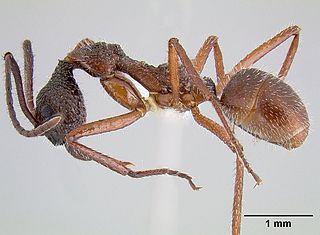
Dolichoderus is a genus of ants found worldwide.

Heteroponera flava is a species of ant in the genus Heteroponera. Endemic to Brazil and Paraguay, it was described by Kempf in 1962.
Heteroponera robusta is a species of ant in the genus Heteroponera. Endemic to Brazil, it was described by Kempf in 1962.

Dolichoderus attelaboides is a species of ant in the genus Dolichoderus. Described by Johan Christian Fabricius in 1775, the species is endemic to Bolivia, Brazil, Ecuador, French Guiana, Guyana, Peru, Suriname and Trinidad and Tobago.
Dolichoderus baenae is a species of ant in the genus Dolichoderus. Described by Mackay in 1993, the species is endemic to Colombia.
Dolichoderus clusor is a species of ant in the genus Dolichoderus. Described by Auguste-Henri Forel in 1907, the species mostly live in dry sclerophyll and forages on tree trunks. Populations are known from Western Australia and South Australia. Ants of this species have been observed nesting under masses of dead grass, which were located under a stone.
Dolichoderus elegans is an extinct species of Eocene ant in the genus Dolichoderus. Described by William Morton Wheeler in 1915, the fossilised remains of the species were found in the Baltic amber.
Dolichoderus gagates is a species of ant in the genus Dolichoderus. Described by Emery in 1890, the species is endemic to multiple countries, including Bolivia, Brazil, French Guiana, Guyana, Suriname and Venezuela.
Dolichoderus haradae is a species of ant in the genus Dolichoderus. Described by Mackay in 1993, the species is endemic to Brazil.
Dolichoderus inermis is a species of ant in the genus Dolichoderus. Described by Mackay in 1993, the species is endemic to Costa Rica.
Dolichoderus lobicornis is a species of ant in the genus Dolichoderus. Described by Kempf in 1959, the species is endemic to Brazil and Ecuador.
Dolichoderus mesonotalis is a species of ant in the genus Dolichoderus. Described by Auguste-Henri Forel in 1907, the species is endemic to Brazil and Peru.
Dolichoderus niger is a species of ant in the genus Dolichoderus. Described by Crawley in 1922, the species is endemic to Australia, and can be seen in scrub like habitats in Western Australia, and has been observed in native woodland around the city of Perth.
Dolichoderus omacanthus is a species of ant in the genus Dolichoderus. Described by Kempf in 1972, the species is endemic to Brazil.
Dolichoderus piceus is a species of ant in the genus Dolichoderus. Described by Mackay in 1993, the species is only known in Colombia.
Dolichoderus quadridenticulatus is a species of ant in the genus Dolichoderus. Described by Roger in 1862, the species is endemic to South America.
Dolichoderus rugosus is a species of ant in the genus Dolichoderus. Described by Smith in 1858, the species is endemic to South America.
Dolichoderus setosus is a species of ant in the genus Dolichoderus. Described by Kempf in 1959, the species is endemic to Brazil.

Dolichoderus taschenbergi is a species of ant in the genus Dolichoderus. Described by Mayr in 1866, the species is endemic to Canada and the United States.

Dolichoderus validus is a species of ant in the genus Dolichoderus. Described by Kempf in 1959, the species is endemic to North America and South America.




